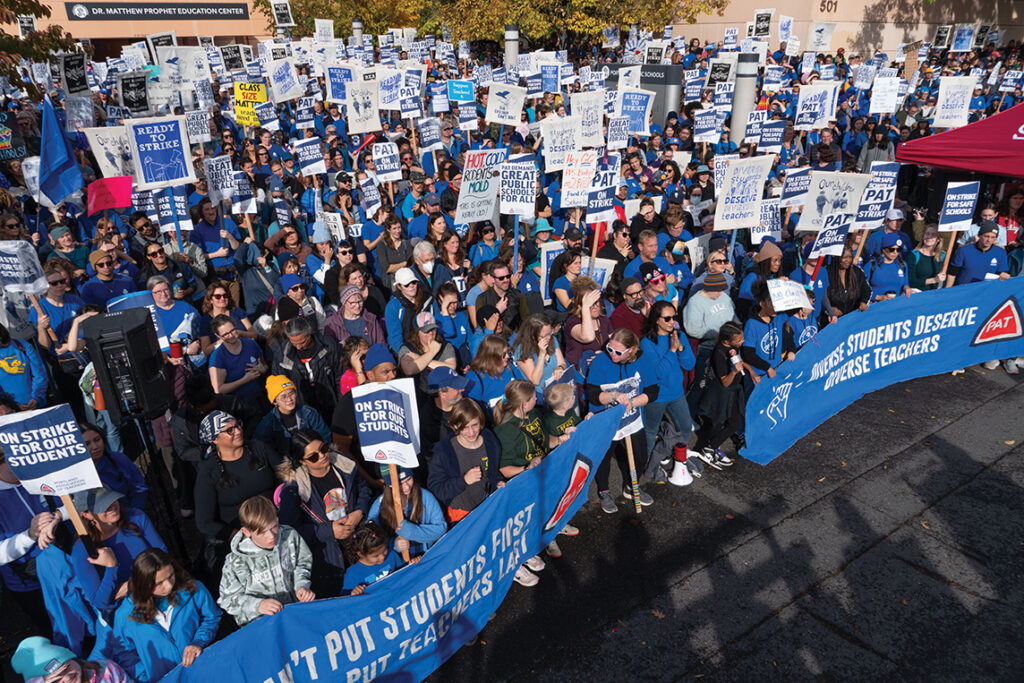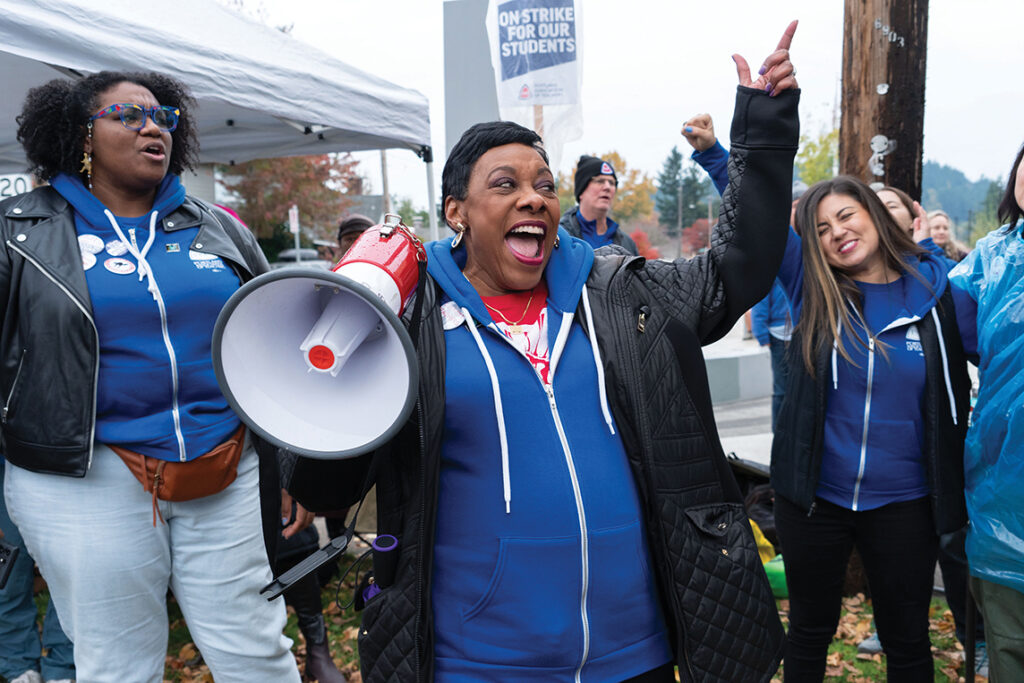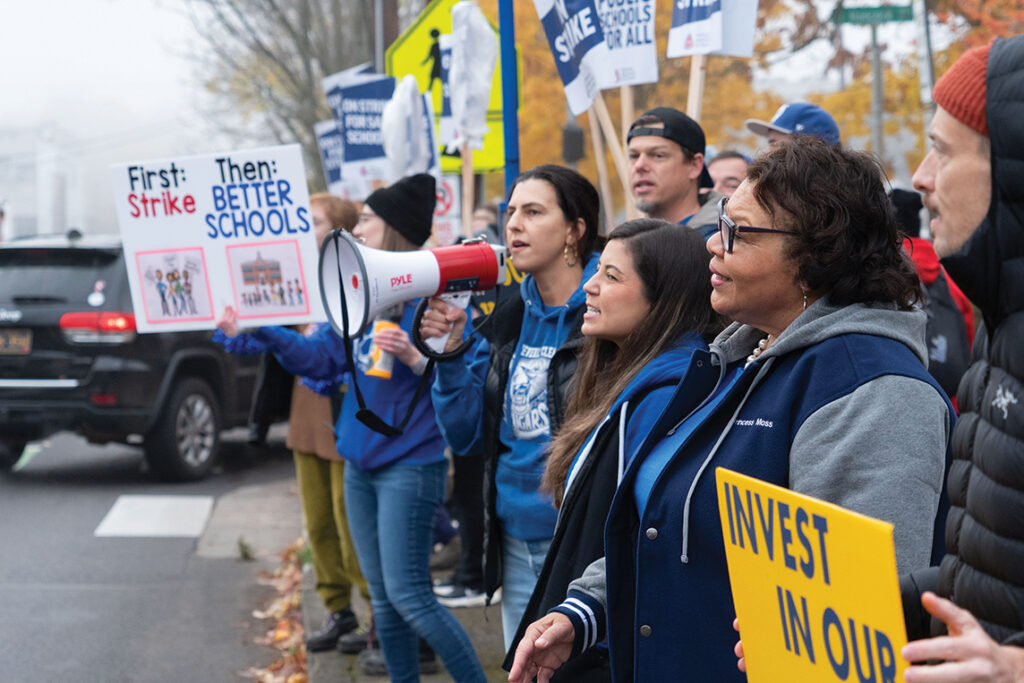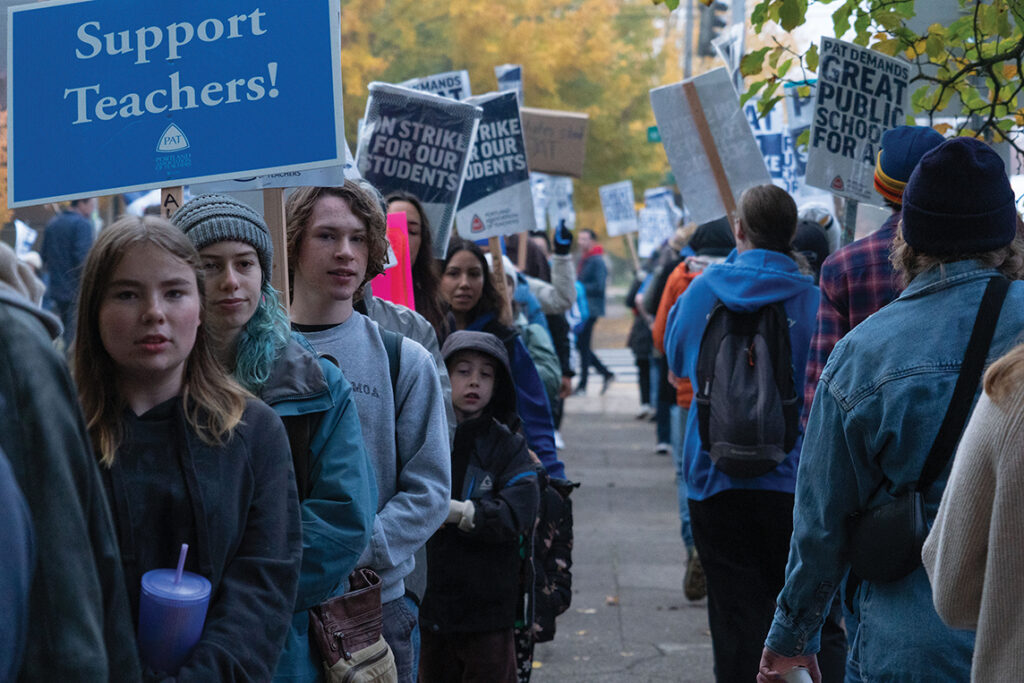How Portland Teachers Led the Longest K–12 Strike in Decades
Illustrator: Joe Brusky

We’ll never forget the day when we knew that we would win. It was 8:30 a.m. on Nov. 21, more than three weeks into the first-ever Portland, Oregon, teachers strike. We were rally marshals, tasked with walking ahead of the march to troubleshoot potential issues. Accompanied by the dull hum of a nearby freeway and the caws of seagulls above the Willamette River, we stood on the sidewalk waiting — hoping that a parade of educators would soon join us.
They had every reason not to. As frustration mounted with district leaders and their refusal to address our demands for safe, equitable, and sustainable schools, so did skepticism of our union’s strategy. Educators started to openly question our bargaining team. Others felt concerned about the use of civil disobedience. Some worried that if the strike continued, they would lose health care or not meet rent payments. Trying not to let the doubt in colleagues’ minds creep into our own, we made ourselves look busy, checking in with the other marshals using our walkie-talkies, rubbing our hands together to stay warm.
Then suddenly, we heard the chants. “Education is a right! That is why we have to fight!” and the call-and-response “Whose schools? Our schools!” building in volume as nearly 3,000 educators and supporters, marching shoulder to shoulder, drew nearer. The crowd finally reached the apex, where together we sat and occupied the six-lane Burnside Bridge, at the peak of morning rush hour, for several minutes of silence. We wanted to send a message to our school leaders that their refusal to budge at the bargaining table not only affects us. It harms our students and our whole city. Looking at the determined faces surrounding us, it was clear that despite doubts, we were not giving up our fight for the schools our students deserve.
Two Visions for Public Education
The seeds of our strike were sown 10 years ago. In the 2013–2014 school year, school district leaders demanded more than 75 concessions, including bigger class sizes, fewer workload protections, and cuts to healthcare benefits. Inspired by the historic 2012 Chicago Teachers Union strike, our union launched the Schools Portland Students Deserve campaign. We built a coalition of educators, students, and community leaders ready to protect public schools. Two days before educators were set to strike, school district leaders caved. Many believed this victory represented the start of a new movement for the 49,000 students and their families that our union of 4,000 educators served. But in the wake of this campaign, our union’s organizing infrastructure withered.
Then in 2017, with the hiring of Superintendent Guadalupe Guerrero, school district leaders laid out a vision for how Portland schools should be “reImagined.” This corporate rebranding campaign, wrapped in the language of diversity, equity, and inclusion, pulled answers from the national corporate education (de)form playbook: blame educators while cutting staff at schools, standardize curriculum, and increase testing. School leaders began hiring more administrators and cutting direct student-support positions, especially special education teachers, school psychologists, and social workers. In the name of equity, school leaders pushed for a standardized curriculum that would keep all students at the same grade level using the same materials at the same time. To ensure the new curriculum was being implemented, elementary school educators were forced to administer more standardized tests and submit weekly lesson plans to administrators.
The pandemic, distance learning, and the rush to return to “normal” intensified this crisis. Many educators reached their breaking point. By late 2021, more than 80 percent said their workload was excessive and more than a quarter were considering quitting. At the end of the 2021–2022 school year, district leaders announced plans to cut more than 96 elementary and middle school teaching positions and more special education positions.

A Commitment to Listening
Educators’ frustration led to new union leadership in 2022. Angela Bonilla became president after serving as her building representative and being appointed to the bargaining team the previous year. An Afro-Caribbean Spanish immersion teacher at a high-poverty elementary school, Bonilla ran on a platform of revitalizing the fight for the schools our students deserve through classroom-to-classroom, bottom-up organizing. Bonilla’s running mate was Jacque Dixon, a Latina high school English educator — a longtime building rep with deep roots in racial and social justice communities. Dixon brought grassroots connections with local activists and student artists and performers through her work outside of the classroom.
Bonilla and Dixon wanted to rebuild our union’s organizing culture by recruiting leaders and using issue fights to organize educators to achieve small wins. One priority was to address grievances raised by special education and mental health educators. For years district leaders brushed off concerns about high workload, chronic understaffing, and mistreatment from managers. Many educators worked through lunches and breaks to meet district and federal special education timelines.
Bonilla, Dixon, and others pulled together an ad hoc special education organizing committee, drawing on leaders across different job classifications. They organized a listening session for special education teachers. Educators across grade levels and classifications shared issues they experienced and identified two fundamental problems: persistent understaffing and a lack of support from district leaders. They set up follow-up meetings around their key issues. This led to a week of action featuring a mass protest at a school board meeting, launching a community coalition, and teachers and community members delivering a “class action grievance” to the special education department.
Our union also began to forge wider and deeper relationships with parents, families, and community organizations. We drew on powerful examples through the Bargaining for the Common Good network, a national group of unions and community organizations that support these kinds of campaigns.
In late summer 2022, the union leadership recruited elementary educators Tiffany Koyama Lane and Sven Gunvalson to lead a renewed “external” organizing effort. A team of organizers from schools across the district mapped the largely disconnected parent and community organizations associated with schools. We hosted a series of community listening sessions at schools where educators and the community felt long ignored.
Shifting from Mobilizing to Organizing
While we worked to expand our relationships with parents and the community, we rebuilt our membership organizing structure.
With negotiations set to begin in January 2023, in October 2022 we distributed a bargaining survey through the internal organizing structure already in place. Using paper surveys allowed organizers to have conversations within each building. It also allowed us to identify which sites had a strong internal structure, which did not, and assess the skills needed in the months ahead.
The survey results, paired with what we learned from parents and community members, led to the creation of our bargaining platform. This vision for transforming schools called for smaller class sizes and caseloads, additional special education services, expanded mental health services, safe and healthy schools, less standardized testing, expanded early learning and preschool, racial equity and restorative justice, and housing assistance for at-risk families.
Between October 2022 and April 2023, our internal organizing team designed a series of escalating actions: wearing PAT Blue on Tuesdays, donning buttons that read “Bargaining Today! Ask me what I’m fighting for,” and displaying solidarity posters outside classrooms. Roughly half of our schools had worksite organizing committees. Each action provided opportunities to identify leaders in schools without organizers and develop leaders in those that did. During internal organizing meetings, we charted which schools participated in the actions and which did not. When a leader in the meeting saw a school where they had relationships not participating, they “adopted” the school, reached out to friends, identified leaders, and recruited them to take part in the next meeting or action. Every meeting, we taught organizing skills like mapping your worksite or answering tough questions.
By early May, there was little progress at the bargaining table. District leaders proposed minimal cost of living adjustments and virtually no improvement on workload or special education staffing. They refused to discuss early childhood education, standardized testing, and housing. They claimed they had no money, citing misleading data about school enrollment and a lack of new state funding.
We decided to hold a mass rally at a school board meeting. More than 600 educators attended, the largest rally our union hosted in years, forcing district leaders to stop the meeting due to fire code restrictions. A week later, more than 200 educators crammed into a small district meeting room to attend the bargaining session. District leaders were visibly shaken; more importantly, educators felt a sense of their own power.
With the school year ending and district leaders refusing to budge, it became clear that only a strike would lead to the contract our community deserved. Drawing on examples from the Chicago Teachers Union and United Teachers Los Angeles, we established a Contract Action Team — fusing internal and external organizing committees and our existing building representative structure. Over summer break and the first months of the 2023–2024 school year, we met frequently to shore up our organizing structure and deepen community support. We recruited additional leaders to our Contract Action Team; made phone calls and visits to schools without strong union participation; hired new experienced organizers; drafted plans for the possibility of a strike; and as the strike neared, hosted a three-day art build where hundreds of educators, their families, and community supporters gathered to create beautiful picket signs, banners, and street parachutes.
A coalition of parents, grandparents, and community supporters started the Portland Strike-Ready Teachers Solidarity Campaign. This coalition recruited supporters who distributed leaflets about our key demands and updates about negotiations to families outside elementary and middle schools. They also organized phone banks and door-knocking to distribute “Great Public Schools for All” lawn signs and organize local business support.
At the end of September, we held a “strike school” — a two-day retreat to prepare for a possible strike. More than 150 educators attended, including every future building “strike captain.” We learned how to organize picket lines and talk with the press. During one workshop, NEA organizer Nate Gunderson reminded us that strikes can be messy and that to win we would need to “embrace the chaos.” Many educators felt nervous, knowing that we were on the precipice of something our union had never done before, but it was clear that the fruitless negotiations and false promises of future funds needed to end.
Our union published “A Manufactured Crisis,” a report that rebutted district leaders’ insistence that they could not afford our key demands. Our researchers found that district leaders held more than $100 million that could be spent. Between Oct. 16 and 18, organizers led strike votes in each building. With 93 percent of members participating, 98.9 percent voted to authorize our strike. Three days before our strike was set to begin, more than 4,000 educators and community members led a March for Our Students and Great Public Schools, filling the Burnside Bridge in downtown Portland.
The day before the strike, educators across the district organized walkouts, chanting “For our students! For our schools! For our community!”

Embracing the Chaos
On Nov. 1, educators built picket lines at more than 90 worksites. In the lead-up to the strike, we encouraged educators to think of picket lines as community potlucks — places that welcomed students, families, and supporters and allowed us to educate the community about our key issues. We wanted strike captains to organize picket lines that made the most sense for the community they worked in. Picket lines became mini teach-ins led by students and teachers about conditions in schools. They became dance parties, where educators learned the hidden DJ talents of co-workers. The entrances of schools became art galleries, featuring student creations about what they believed great public schools should be. Some high school picket lines turned into student-led marches distributing “I Love Portland Teachers” window hangs and stickers. Maybe most importantly, picket lines became places to rebuild relationships lost or frayed by the pandemic and the crushing workload. Educators at nearly every picket line commented on how they felt like this was the first time they got to know one another and rekindle relationships with colleagues. A common refrain on the picket line was “This is the best PD I’ve had in years!”
In addition to encouraging creativity and joy on our picket lines, we organized three consecutive days of citywide rallies. Thousands of educators and supporters rallied at high schools, at school district headquarters, and at City Hall. In the pouring rain we chanted “Rain or Shine, We Walk the Line,” “Beep Beep, Toot Toot, Get Up Off of That Loot,” and “Rats, Mold, Hot, Cold, This Is Getting Really Old!” Lawns, businesses, and cars displayed signs of support. Dozens of businesses offered striking teachers meal and drink discounts. Parents, PTAs, and community supporters flooded district leaders with thousands of emails and phone calls urging them to meet our demands. State lawmakers called on school leaders to stop hiding behind claims that they did not have enough money, urging them to meet teachers’ demands.
Fear, Uncertainty, Doubt, Division
We hoped that a powerful showing of educators and community support in the first days of the strike would force district leaders to cave to our demands. However, they instead dug in, opening the door to fear, uncertainty, doubt, and division. The biggest question was whether the district had the money to meet our demands. Despite our union’s research and the findings of Oregon’s chief financial officer that school leaders had more than $12 million more to spend for just the next fiscal year, district leaders continued to claim they had no additional money.
Local media ran anti-educator editorials that tried to poke holes in our demands. Many rank-and-file educators also began questioning our tactics. This came to a head after our union held a rally and march inside the Oregon Convention Center, where one school board leader was in daylong meetings. District leaders described our union’s actions as “violent” and “terrorist,” threatening to file an unfair labor practice (which they never did). Press about the event picked up district leaders’ false narrative. The combination of a lack of progress at the bargaining table and the negative press put stress on educators. Strike captains and member leaders quickly pivoted from the highs of the first week of our strike to answering tough questions about our tactics and plan to win. Educators worried about their next paycheck. And district leaders spread rumors that they would cut our health insurance if we did not return to work before Thanksgiving.
But rank-and-file leaders showed incredible resilience. Educators organized daily regional rallies so those at smaller schools felt buoyed. They organized neighborhood jogs in between morning pickets and afternoon rallies to boost camaraderie. Bargaining team members visited sites to share updates. Students and parents hosted pancake breakfasts and talent shows. Most buildings organized strike resilience funds to help educators pinched by rent and mortgage payments and ongoing medical bills. We adopted an old union chant: “One Day Longer, One Day Stronger.” Daily sign-ins to our picket lines by educators remained steady and the number of community supporter sign-ins continued to grow.
Squeezing Water Out of a Rock
After three weeks on strike, there was growing optimism that a settlement was in reach. The last sticking points were class sizes and cost of living raises, the main issues for most educators. Inflation over the previous three years had eroded salaries, meaning that most educators lost an average of $12,000. As housing costs skyrocketed, stagnant pay made it hard to recruit and retain educators. A 2023 study found that Portland was the second least affordable city for new educators. But district leaders kept proposing salary increases that did not keep up with inflation. Class size caps was another key demand. Earlier contracts set a precedent to pay bonuses to educators with overloaded classes in elementary schools or large overall student numbers in middle and high schools. The thinking at the time was that school leaders would keep class sizes and workloads low and hire more educators to avoid “overage” payments. Instead, district leaders continued to cut teaching positions and overload classrooms.
This time, after three weeks on strike, it seemed like school leaders were finally open to real class size caps, but there was a catch. The caps they would agree to were significantly higher than the softer limits with “overage” payments established in previous contracts. And to win them, educators would have to accept a significantly lower cost of living adjustment and drop our proposal to expand mental health crisis teams. At a standing room only meeting, Angela Bonilla described to building representatives the hard choices we faced: “Right now, negotiations are like squeezing water from a rock. We’ve put as much pressure as we can on these leaders to do the right thing. But they are refusing to budge.”
We continued to hold the line. On day 13 of our strike, parents and grandparents of students occupied the Multnomah County headquarters, where one school board member worked, while educators rallied outside. On day 14, more than 3,000 educators and supporters marched again over the Burnside Bridge. And on day 15 we surrounded City Hall, singing a reworked version of the Ramones’ “Blitzkrieg Bop,” with the refrain: “We’re feeling upbeat, we won’t stop! Hey, ho, let’s go!”

What We Did, and Didn’t, Win
On Sunday, Nov. 26, after holding the line for 15 working days and 26 calendar days, our bargaining team reached an agreement with school leaders. Described by our bargaining team as a “watershed moment for Portland students, families, and educators,” we secured wins on key priorities. School leaders agreed to a 13.75 percent cost of living adjustment over three years, the largest increase in our union’s history. We increased special education and mental health supports, including adding back mental health positions previously cut. Elementary and middle school educators won more than 90 more minutes per week of planning time, and high school educators won additional planning and grading days. We also won novel building safety language that, for the first time, forces school leaders to act when a classroom is below 60 degrees or above 80 degrees, and when rodents or mold are present.
The same is true for class size. Although we did not win hard class size caps, we did win the creation of committees that, when a classroom or educators’ class sizes hit the “overage” threshold, require school leaders to meet with educators and parents to discuss class sizes in schools. We also won expanded academic freedom, including less instructional time spent on standardized testing, and commitments to improve early childhood education and housing support for families.
And yet, many educators are disappointed. We did not win the clear victory on class size caps that seemed so close. Nor did we win enough mental health positions given the ongoing crisis in our schools. And the wins we made are largely deferred. It’ll take months before new special education and mental health resources become available. It’ll take a year for the increased planning time to take effect. Even our wage increases will take time to be fully felt.
Still, the day after the strike ended, Oregon Gov. Tina Kotek, who largely stayed on the sidelines of our fight, announced new task forces to address the issues we raised, especially mental health and building conditions. Two weeks after our strike ended, Superintendent Guadalupe Guerrero and his chief of staff resigned. Our fight is nowhere near over. In February, school leaders announced a wave of staffing cuts and implying what we won is to blame. It’s too soon to know if these proposed cuts will become real, but real or not, they are not new. School leaders lament budget shortfalls and threaten cuts every few years. What is new is that more educators are now participating in our union, readying for another round of state legislative negotiations, discussing ways they can sustain the community coalition built through the strike, and of course, fighting back against this latest round of harmful cuts. It will be up to all of us to digest the lessons of our three weeks on the picket line to rebuild our sense of unity and power. It will be up to us to keep fighting, with our community, for the schools Portland students deserve.

